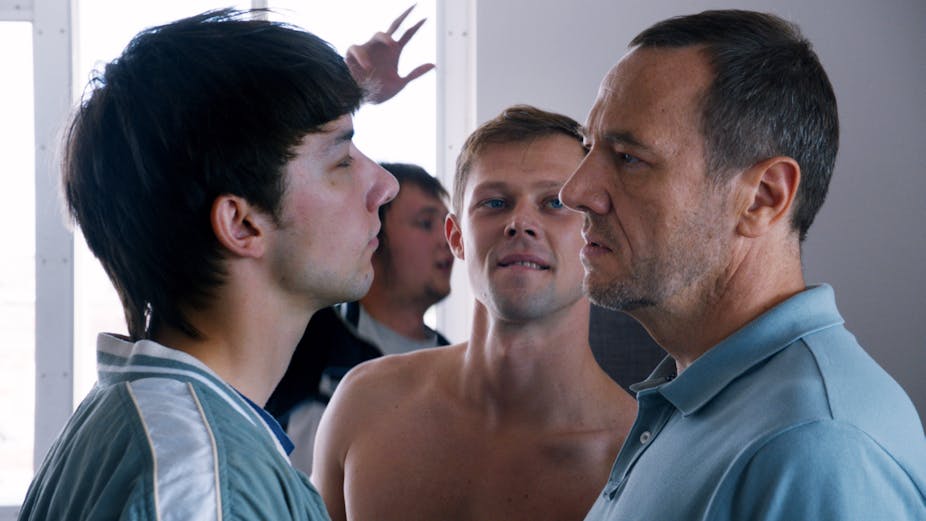The camera, situated in the middle of the foyer of a public building, looks through large windows into the street and city beyond. The protagonist couple of Eastern Boys – affluent Frenchman Daniel (Olivier Rabourdin), and young “eastern boy” Marek (Kirill Emelyanov) – emerge from a courtroom, crossing the shot and exiting the building.
The camera, assuming a kind of bureaucratic stateliness, shows no interest in the pair, who become simply two more bodies on the busy midday street. In a film which is primarily an extremely intimate character-study of this couple and their relationship, this lack of response seems particularly salient. The camera instead slow tracks towards the massive windows. These are the windows blocking out the noise of the street beyond and they clearly mark the divide between those within the building and those outside.
This, the final shot of Robin Campillo’s film, which won the Best Film award at last year’s Venice Film Festival, is one of a few key sequences that emphasises the affective characteristics of (and generated by) different forms of space. In a narrative about sans-papiers – France’s illegal immigrant workers – the divide between inside and outside the building is crucial. The state building as façade of government and the street beyond are analogous to the divide between France (the “West”) and the “East” which gives the film its title.
The basic narrative of the film follows the relationship between Daniel and Marek. Daniel arranges a tryst with Marek after he meets him at a train station. The brilliant opening sequence recalls the surveillant-eye style of Coppola’s The Conversation (1974). Marek arrives at Daniel’s apartment with a gang of fellow “eastern boys,” who proceed to steal Daniel’s valuables, including his chic furniture. The next day, to Daniel’s surprise, Marek comes back to fulfil their sexual contract.

Despite the tenderness with which Campillo depicts the burgeoning romance between Daniel and Marek – and the skill with which the transition of their relationship is handled – this is no Pretty Woman. There is, at all times, a deep sense of the injustice of this relationship, and a profound uneasiness regarding commodification in general – of goods, labour, and city.
There is a sense of stillness to the way the images (and events) unfold before our eyes. This effect is enhanced by the novelistic conceit of the film’s arrangement in titled “chapters” – and yet it’s a stillness simmering with latent tension.
This tension erupts in the final stages of the film into violence against the gang and (by extension, and incidentally), against a hotel-full of a variety of sans-papiers, from “south” as well as “east.” Marek has been kidnapped by his gang in an act of jealousy initiated by the gang’s leader, “Boss” (Daniil Vorobyev), and Daniel, unable to rescue him on his own, calls in the police. They arrive at the hotel waving batons and guns, and chase, maul and arrest whoever they can get their hands on.
The injustice is not lost on the viewer: Daniel’s act has, in effect, condemned 50 or so for the sake of one, his glorified “toy boy”. This wrong is amplified by our sense of the a priori inequality of Daniel and Marek’s relationship – or, really, of any relationship commodified in this fashion.
French anthropologist Marc Augé coined the term “non-places” (“non-lieux”) in his epochal work Non-Places: An Introduction to Supermodernity, to describe all of those oddly depthless places that have proliferated in the modern age, spaces of pure transition and circulation: airports, malls, hotels.
Eastern Boys, its action bookended by two such “non-places” (a train station and a hotel), seems to draw a connection between this evacuation of significant space and the dehumanising itinerancy of the stateless in the age of mass migration. The film’s narrative occurs within carefully defined and delimited, contained, spaces, across three basic locations – the train station; Daniel’s apartment; and the suburban hotel.

These locations form a triangle of sorts – station-apartment-hotel, with the apartment at the apex – that both maps and reveals the inequality embedded in the relationship between citizen and alien. The sans-papiers are relegated to the “non-places” of the film, spaces of uneasy transition – station and hotel – while the citizen is able to live, literally “high up,” in an apartment overlooking everything below.
This emphasis on the politics of space – including, of course, the myriad shots from Daniel’s apartment down on the city below – complicate what could otherwise be construed as yet another entry into the ledger of both French and Hollywood depictions of the “eastern” European (usually Russian), as sadistic, violent barbarian, a recent resurgence of Orientalism in popular cinema (Taken, The Equalizer) that is yet to be closely examined.
Eastern Boys is released nationally on February 26.

